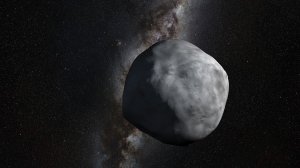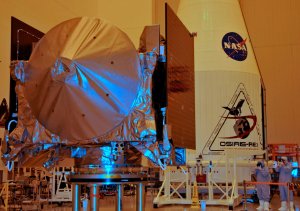
CAPE CANAVERAL, Fla. — NASA is sending a space probe to chase down a dark, potentially dangerous asteroid. The probe will take a sample of the asteroid and — in a U.S. space first — bring the sample back to Earth.
“This is a dark asteroid that we have found and we’re going to hunt down, we’re going to orbit, we’re going to take a good look at it and we’re going to bring back a sample,” Jim Green, director of NASA’s Planetary Science Division, said at a news briefing on Aug. 17.
If you’re thinking this sounds a bit like the plot from the 1998 sci-fi flick “Armageddon” you would be right, but without Bruce Willis (there won’t be any people of this spacecraft) and without space shuttles (NASA retired the shuttles in 2011).
In this real life story, NASA’s OSIRIS-REx space probe will spend two years flying through space to catch up to an asteroid named Bennu, a big, roundish space rock that has made it onto NASA’s list of Potentially Hazardous Asteroids.
That means Bennu is one of the most dangerous space rocks we know of because it could one day collide with Earth.
Launch is scheduled for 5:05 p.m. MDT thursday with backup launch windows for an additional 33 days. OSIRIS-REx will lift off from Cape Canaveral on top of a United Launch Alliance Atlas V 411 rocket.
What OSIRIS-REx will do?
The probe is scheduled to arrive at Bennu in August 2018. For months it will hang out — take pictures, make scans of the asteroid’s surface and create a map.
“We’re going to get to asteroid Bennu and we’re going to map this brand new world that we’ve never seen before,” said Dante Lauretta, the mission’s principal investigator.
Then, in July 2020, OSIRIS-REx will unfurl its 11-foot long robot arm called “TAGSAM” and make contact with Bennu’s surface for about five seconds. During those few seconds, the arm will use a blast of nitrogen gas to kick up rocks and dust and then try to snag a sample of the dust and store it.
“The big prize is going to be achieved when we get a sample of Bennu,” said Jeffrey Grossman, OSIRIS-REx program scientist. “We don’t technically land on Bennu, but we make contact with it for about five seconds.”
NASA hopes to get at least 2 ounces and maybe as much as 4.4 pounds of asteroid litter. There is enough nitrogen on board to try three times to grab the sample.

The spacecraft heads home in March 2021 and arrives back at Earth on Sept; 24, 2023, but it won’t land. In a bit of Hollywood-style drama, it will fly over Utah and drop off the capsule holding the asteroid sample. A parachute will guide the capsule to the ground at the Utah Test and Training Range in Tooele County, Utah.
The mission will “help us understand why we are here, how we are here and how likely it is that this kind of process — origin and evolution of life — may have occurred elsewhere in the solar system and even throughout the galaxy,” said Lauretta.
They’ll also study how Bennu gets around in space. That will help understand how to stop it — if it heads toward Earth one day.
To do this, they’re going to measure a phenomena called the “Yarkovsky Effect.”
Here’s how it works: The sun heats up the asteroid. The asteroid releases that heat back into space and it acts like a thruster, changing the direction of the asteroid.
“If you want to be able to predict where an object like Bennu is going to be in the future, you have to account for this phenomena,” Lauretta said.
Will Bennu really hit Earth?
The short answer is maybe. But if it does, it’s big enough to do some damage.
Bennu has a diameter of 1,614 feet. NASA said it’s more like a “rubble pile” than a solid rock.
It makes its next approach to Earth in 2135 when it will pass just inside the moon’s orbit. But this close approach will change Bennu’s orbit and scientists say that could cause it to impact Earth sometime between 2175 and 2199.
The odds are small — about 1 in 2,500. But NASA wants to get as much warning as possible for anything that threatens Earth.
It’s worth pointing out that while Bennu is a known threat, NASA said only about 51 percent of the near-Earth asteroids of Bennu’s size have been found.
Meaning there could be lots of unknown threats out there.
Earth has been hit by asteroids. The planet is bombarded with more than 100 tons of dust and small particles every day and most of it comes from asteroids. Those smaller bits burn up in our atmosphere, some causing “shooting stars.”
But larger, intact asteroids also make it through. In 2013, an asteroid exploded over Russia’s Chelyabinsk region, injuring hundreds of people and shattering glass on buildings.
A space rock is believed to have entered the atmosphere over Tunguska in Siberia in 1908, knocking down trees for hundreds of square miles.
And then there are the asteroids that hit the ground.
Examples include Arizona’s Meteor Crater near Flagstaff and the undersea impact crater off the Yucatan Peninsula in Mexico that is believed to have led to the extinction of the dinosaurs 66 million years ago.